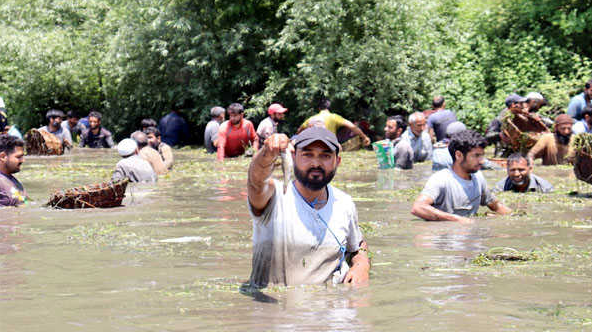ENVIRONMENTAL ETHICS
In the midst of the scorching heatwave in the Kashmir Valley—a South Kashmir village turns into the focal point of an unusual combination of tradition, community, and environmental protection. Each year, on one Sunday in mid-May, Panzath villagers unite at the holy Panzthnag spring and its streams, not only to fish, but to purify and rejoice at the age-old relationship with the environment. This is the Panzath Fish-cum-Dredging Festival – a festival that embodies environmental ethics through communal participation.
Even before sustainability became a catchword worldwide, the people of Panzath knew and did it the way it is supposed to be done. The Panzth ‘nag’ (spring), the source of freshwater supplying and irrigating the surrounding areas, has been the lifeline of many villages for centuries. This activity is special not just because of the fishing but also due to the dredging and maintenance of the spring and its feeder streams. This yearly cleaning ceremony guarantees the unrestricted flow of water, conservation of aquatic organisms, and the well-being of the ecosystem.
The process is totally manual and non-mechanized. Men, adolescents, and even children wade into the water with nets, baskets, and open hands—fishing while at the same time clearing silt, weeds, plastic, and other trash. There are no machines, no chemicals, and no din—just the beat of water, laughter, and an abiding sense of collective responsibility.
This tradition clangs with a centuries-old historical anecdote during the era of Awantivarman, 9th-century king of Kashmir. His master engineer Suya, seeking to dredge the highly silted River Jhelum, notoriously tossed coins into the river. In response to the coins, the people voluntarily cleaned the riverbed. The legend of Suya is most famously recounted by environmentalists as well as historians to highlight how community-based conservation practices are instilled in Kashmiri culture.
In the same vein, Panzth’s Fish-cum-Dredging Festival brings to life this very essence—a grassroots environmental effort that is both ecologically relevant and culturally meaningful.
For several decades, this festival was a local affair, enjoyed by the villagers with minimal external visibility. However, due to the influence of social media, the festival came to limelight. Videos of villagers dancing in the water, pulling nets, and smiling with their catches went viral—catching the attention of audiences far and wide.
The tradition garnered its greatest appreciation when the Prime Minister of India referenced it in his monthly “Mann Ki Baat” programme, congratulating the environmental awareness of the Panzth villagers. This recognition propelled the festival to national status, attracting journalists, media outlets, and interested tourists from all over the valley and farther afield.
The novelty of the festival doesn’t stop at fishing or cleaning. When dusk falls, the village enters its more serious and spiritual phase. People proceed on foot to the graveyard of the village, bearing flowers and water. They sprinkle water over the graves, scatter flowers, and recite “Fateha” (prayer) for their dead ones. The spiritual ritual, Roohan Poush, infuses the day with a highly emotional and respectful aspect—where ecological cleaning is accompanied by soul-purging.
To the observer, the Panzth Fish-cum-Dredging Festival is a colorful spectacle. Champs, teens, and seniors—all wade into the waters with festive hearts and spirit of community. Song rings through the village, folk dance erupts in the stream itself, and numerous selfies record the moments of togetherness and joy. Kids giggle with excitement as their elders teach them the art of fishing—ensuring that this cherished tradition is passed down to future generations.
This is not a mere festival—it is an ode to life, nature, memory, and harmony. In its essence, the Panzath Fish-cum-Dredging Festival is a model of grassroots environmentalism. It informs us that environmental conservation does not always entail grand policies or foreign assistance. Sometimes, it simply takes willpower from the people, culture, and nature love.
As climate change intensifies and ecosystems face growing threats, such local, sustainable, and culturally rooted practices offer both hope and inspiration. Panzath has shown the way—clean your water, cherish your heritage, honor your dead, and dance while doing it.
Let us hope that such festivals are not only celebrated but replicated, with Panzath standing as a shining example of how tradition and environmental ethics can go hand in hand.
(The Author is Environmental Geographer and teaches Geography at Altaf Memorial Government Degree College Kelam Kulgam. Email: [email protected])







